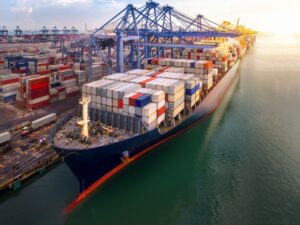 I would like to thank everyone for your support in 2021. It has been a year full of challenges for me. First, in February, I was interviewed from TV Tokyo’s World Business Satellite, which was broadcasted immediately on the same day, and in April, I embarrassingly started YouTube. On the other hand, I gained weight during COVID-19 lockdown, but thanks to diet restriction and my loving wife(?) who has forced me to have the nutrition-controlled lunch-box prepared by her, I’ve been able to get my weight back from 75kg down to the 70kg.
I would like to thank everyone for your support in 2021. It has been a year full of challenges for me. First, in February, I was interviewed from TV Tokyo’s World Business Satellite, which was broadcasted immediately on the same day, and in April, I embarrassingly started YouTube. On the other hand, I gained weight during COVID-19 lockdown, but thanks to diet restriction and my loving wife(?) who has forced me to have the nutrition-controlled lunch-box prepared by her, I’ve been able to get my weight back from 75kg down to the 70kg.
Meanwhile, the world is still in the midst of fighting against COVID-19. The Omicron variant found in South Africa has spread rapidly to more than 30 countries in Europe, the United States, Canada, India, Australia, South Korea, and Japan, within a week since the World Health Organization (WHO) designated it as Variant of Concern (VOC). It is currently unknown how the Omicron variant will cause a pandemic in the future. Just as the economy has begun to recover, there is a great concern about how the new highly infectious Omicron variant will affect the global supply chain.
According to the November employment figures released by the U.S. Labor Department on November 3rd, the number of nonfarm workers increased by 210,000, down from 546,000 in October. However, the unemployment rate improved by 0.4 points from the previous month to 4.2%, indicating that the labor market is recovering steadily and can’t keep up with demand for jobs. The U.S. economy continues to make a strong comeback. However, it is unclear what will happen to it depending on the pandemic of the Omicron variant.
Congestion at North American ports is said to be improving, but it is just because of the change in the counting method of vessels waiting for berth. The number of vessels waiting for berth at the Port of Long Beach and Los Angeles reached a record high as of December 2nd. It is said that there are 40 vessels within 40 miles, and 56 vessels within 150 miles of the coast, with a total of 96 vessels waiting offshore. If the ships are included that are adjusting speed to delay arrival by slowing down, the number is close to 100. It seems that it will still take some time for the U.S. port situation to improve. As of December 8th, the surcharge on long-stay containers at the Port of Los Angeles and Long Beach was postponed for the fourth time on December 13th. It is very doubtful whether the problem can be solved by unilaterally imposing penalties on shippers.
 Shipping Guide cites Drewry Maritime Research (UK). The overall World Container Index (WCI) released on December 2nd is $9,050.77 per FEU, down 1.5% from the previous week and 196% above the same period last year. The average since the beginning of the year is $7,447 per FEU, which is $4,738 per FEU above the average of $2,709 per FEU for the past five years. By route wise, Shanghai -> NYC index fell 5% ($648) from the previous week to $12,582 per FEU, while Shanghai -> LA slumped 4% ($387) to $9,698 per FEU. Shanghai -> Rotterdam was $13,500 per FEU, and Shanghai -> Genoa was $12,480 per FEU, flat compared to the previous week respectively.
Shipping Guide cites Drewry Maritime Research (UK). The overall World Container Index (WCI) released on December 2nd is $9,050.77 per FEU, down 1.5% from the previous week and 196% above the same period last year. The average since the beginning of the year is $7,447 per FEU, which is $4,738 per FEU above the average of $2,709 per FEU for the past five years. By route wise, Shanghai -> NYC index fell 5% ($648) from the previous week to $12,582 per FEU, while Shanghai -> LA slumped 4% ($387) to $9,698 per FEU. Shanghai -> Rotterdam was $13,500 per FEU, and Shanghai -> Genoa was $12,480 per FEU, flat compared to the previous week respectively.
Ocean freight also seems to have hit the ceiling. Some say that the current high ocean freight rates will end around the Chinese New Year in February. On the other hand, others expect it will last until the first half of next year or continue through 2022. The reason for this is that the U.S. West Coast Port Labor-Management Agreement expires on July 1st, 2022. So, in the middle of last month, the employers’ group PMA (Pacific Maritime Association) asked the ILWU (International Longshore and Warehouse Union) for a one-year extension, which was refused by the Union. Last time, the U.S. government intervened to extend the agreement for three years from its original expiration date of July 1st, 2019, to July 1st, 2022. Depending on the discussions with the PMA, the possibility of the ILWU going on strike cannot be denied.
The newbuild container price for November was $3,750 per 20f, down $100 or 2.7% from October’s newbuild price of $3,850 per 20f dry. 557,399 TEU (Dry: 544,645 TEU, Reefer: 12,754 TEU) were manufactured in November. Compared to October’s dry production only, the number decreased by about 9% or 55,779 TEU. As of the end of November, factory inventory was 759,448 TEU (Dry: 701,048 TEU, Reefer: 58,400 TEU). This is an increase of 336,228 TEU compared to the August inventory. It can be said that shipping companies are becoming less dependent on leasing companies for newbuild containers. The shipping companies are probably covering the shortage by positioning back containers they are currently operating and using some of the remaining long-term leases. As a result, it seems that the price of new containers is beginning to adjust.
There is a movement to raise the minimum wage in China. The central government requires local governments to review the minimum wage every two to three years. In 2021, 20 provinces, municipalities, and autonomous regions have raised their minimum wages in an effort to achieve “common prosperity”. China’s labor cost is higher than that of Thailand, Malaysia, Vietnam and other Southeast Asian countries. As a result, there is a trend to shift manufacturing bases from China to Southeast Asia. If labor cost continues to rise, the relocation of factories outside China is expected to accelerate. It was a topic a while ago that Chinese company HNA Group became bankrupt in January 2021 with debts of more than 11 trillion yen is an old story, but now the real estate giant Evergrande Group is in financial crisis with debts of more than 33 trillion yen, which is about 2% of China’s nominal GDP. China is facing many domestic issues such as the default problem of local state-owned enterprises and the Chinese government’s strict control over private IT companies. It is likely that there will be a rush for exports before the Chinese New Year next year, but the fact that the Chinese Yuan has been rising against the dollar since the second half of this year is also a major concern for exporters. For this reason, ocean freight from China is also expected to settle down gradually.
 An article in Nikkei dated December 3rd titled “ENEOS to turn waste plastic into crude oil” reports that ENEOS and Mitsubishi Chemical will jointly start operating a facility to turn waste plastic into oil similar to crude oil in fiscal 2023. The article says they aim to process 20,000 tons per year. The purpose of the chemical recycling is to reuse the waste plastic that until now could not have been separated and were either burned or buried. The recycled plastic can be reused over and over again as waste plastic. It is expected to reduce the amount of oil used and also reduce carbon dioxide emission by more than 50% compared to incineration. European companies are leading the way in chemical recycling, and they provide Japanese companies with production technology. In order to accelerate the decarbonization process, I hope that Japanese companies will create new business opportunities through technological innovation to process and utilize the waste plastic produced in our own country. I wish that the government will give an unstinting support to private sectors, taking into consideration of Japan’s interests of 30 to 50 years later, not just focusing on short-term profits.
An article in Nikkei dated December 3rd titled “ENEOS to turn waste plastic into crude oil” reports that ENEOS and Mitsubishi Chemical will jointly start operating a facility to turn waste plastic into oil similar to crude oil in fiscal 2023. The article says they aim to process 20,000 tons per year. The purpose of the chemical recycling is to reuse the waste plastic that until now could not have been separated and were either burned or buried. The recycled plastic can be reused over and over again as waste plastic. It is expected to reduce the amount of oil used and also reduce carbon dioxide emission by more than 50% compared to incineration. European companies are leading the way in chemical recycling, and they provide Japanese companies with production technology. In order to accelerate the decarbonization process, I hope that Japanese companies will create new business opportunities through technological innovation to process and utilize the waste plastic produced in our own country. I wish that the government will give an unstinting support to private sectors, taking into consideration of Japan’s interests of 30 to 50 years later, not just focusing on short-term profits.
As the world is moving towards decarbonization and effective use of limited resources, the Japanese government, as a major resource importer, should not waste tax payers’ money. Nonetheless, there are still 80 million masks left in warehouse, which Prime Minister Abe decided to distribute in 2020 to combat COVID-19, and the storage cost has reached 600 million yen. In addition, the Abe administration has outsourced the work of subsidy program for sustaining businesses to “Service Design Promotion Council” at a cost of 76.9 billion yen, while they in turn passed it on to Dentsu for 74.9 billion yen. This private contractor, Service Design Promotion Council, was established in 2016 by Dentsu and the temporary employment agency Pasona and etc. The Kishida administration also plans to provide 100,000 yen to those under 18 years old as a COVID-19 countermeasure, by 50,000 yen in cash via bank transfer by the end of the year and by 50,000 yen in coupons distributed next spring. The administrative costs are estimated to be 28 billion yen for the cash transfer and 96.7 billion yen for the coupon distribution. Is this the “new capitalism” that the Kishida administration is promoting? Isn’t the essence of capitalism to eliminate waste and increase the real effect? In this way, no matter how much money we have, we will never have enough, and it will be difficult to get the young people of Japan interested in politics.
(Translated by Ms. Chizuru Oowada)